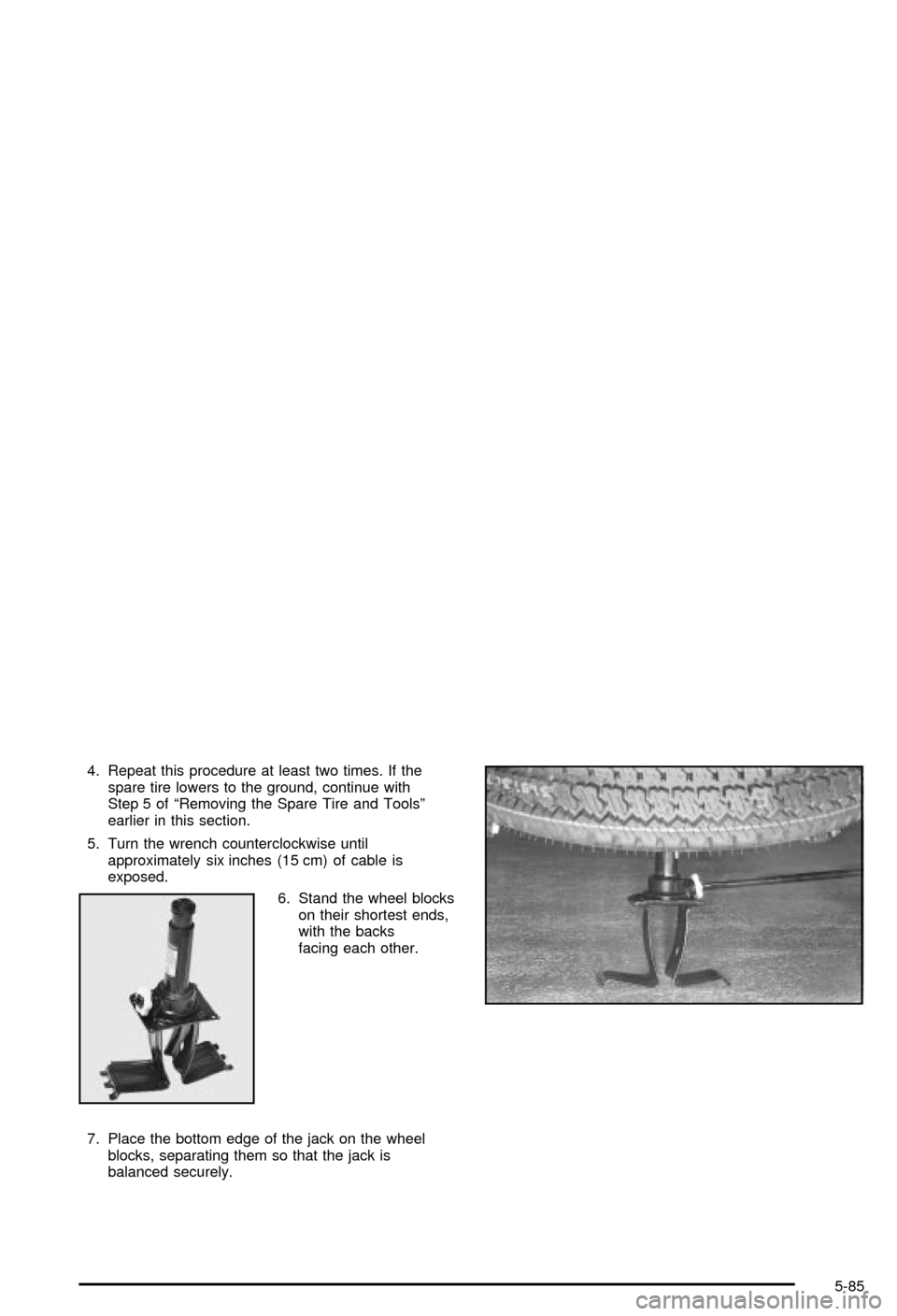ECU CHEVROLET AVALANCHE 2003 1.G Workshop Manual
[x] Cancel search | Manufacturer: CHEVROLET, Model Year: 2003, Model line: AVALANCHE, Model: CHEVROLET AVALANCHE 2003 1.GPages: 492, PDF Size: 3.53 MB
Page 318 of 492

Say, for example, you have a 700 lb. (318 kg) snow
plow. The total weight of all occupants and cargo inside
the cab should not exceed 300 lb. (135 kg). This
means that you may only be able to carry one
passenger. But, even this may be too much if you've
got other equipment already adding to the weight of your
vehicle.
Here are some guidelines for safely carrying a snow
plow on your vehicle:
·Make sure the weight on the front and rear axles
doesn't exceed the axle rating for each.
·For the front axle, if more cargo or passengers must
be carried, appropriate counter ballast must be
installed rear of the rear axle. Counter ballast must
be properly secured so it won't move during driving.
·Follow the snow plow manufacturer's
recommendations regarding rear ballast. Rear
ballast may be required to ensure a proper front and
rear weight distribution ratio, even though the actual
weight at the front axle may be less than the front
axle rating.
·The snow plow manufacturer or installer can assist
you in determining the amount of rear ballast
required, to help make sure your snowplow/vehicle
combination does not exceed the GVW rating, the
front and rear axle ratings, and the front and rear
weight distribution ratio.
·The total vehicle must not exceed the GVW rating.
Q:What is front axle reserve capacity, and how do
I calculate it?
A:Front axle reserve capacity is the difference
between your front GAWR and the front axle
weight of your truck with full fuel and passengers.
Basically, it's the amount of weight you can
add to your front axle before reaching your front
GAWR.
The front axle reserve capacity for your vehicle can be
found in the lower right corner of the Certi®cation/Tire
label, as shown.
United States
Canada
4-55
Page 328 of 492

Before you start, check the trailer hitch and platform
(and attachments), safety chains, electrical connector,
lamps, tires and mirror adjustment. If the trailer has
electric brakes, start your vehicle and trailer moving and
then apply the trailer brake controller by hand to be
sure the brakes are working. This lets you check your
electrical connection at the same time.
During your trip, check occasionally to be sure that the
load is secure, and that the lamps and any trailer
brakes are still working.
Following Distance
Stay at least twice as far behind the vehicle ahead as
you would when driving your vehicle without a trailer.
This can help you avoid situations that require
heavy braking and sudden turns.
Passing
You'll need more passing distance up ahead when
you're towing a trailer. And, because you're a good deal
longer, you'll need to go much farther beyond the
passed vehicle before you can return to your lane.
Backing Up
Hold the bottom of the steering wheel with one hand.
Then, to move the trailer to the left, just move that hand
to the left. To move the trailer to the right, move your
hand to the right. Always back up slowly and, if possible,
have someone guide you.
Making Turns
Notice:Making very sharp turns while trailering
could cause the trailer to come in contact with the
vehicle. Your vehicle could be damaged. Avoid
making very sharp turns while trailering.
When you're turning with a trailer, make wider turns
than normal. Do this so your trailer won't strike
soft shoulders, curbs, road signs, trees or other objects.
Avoid jerky or sudden maneuvers. Signal well in
advance.
Turn Signals When Towing a Trailer
The arrows on your instrument panel will ¯ash whenever
you signal a turn or lane change. Properly hooked up,
the trailer lamps will also ¯ash, telling other drivers
you're about to turn, change lanes or stop.
When towing a trailer, the arrows on your instrument
panel will ¯ash for turns even if the bulbs on the trailer
are burned out. Thus, you may think drivers behind
you are seeing your signal when they are not. It's
important to check occasionally to be sure the trailer
bulbs are still working.
4-65
Page 395 of 492

In¯ation -- Tire Pressure
The Certi®cation/Tire label, which is on the rear edge of
the driver's door, shows the correct in¯ation pressures
for your tires when they're cold. ªColdº means your
vehicle has been sitting for at least three hours or driven
no more than 1 mile (1.6 km).
Notice:Don't let anyone tell you that underin¯ation
or overin¯ation is all right. It's not. If your tires
don't have enough air (underin¯ation), you can get
the following:
·Too much ¯exing
·Too much heat
·Tire overloading
·Bad wear
·Bad handling
·Bad fuel economy
If your tires have too much air (overin¯ation), you
can get the following:
·Unusual wear
·Bad handling
·Rough ride
·Needless damage from road hazards
When to Check
Check your tires once a month or more.
Also, check the tire pressure of the spare tire.
How to Check
Use a good quality pocket-type gage to check tire
pressure. You can't tell if your tires are properly in¯ated
simply by looking at them. Radial tires may look
properly in¯ated even when they're underin¯ated.
Be sure to put the valve caps back on the valve stems.
They help prevent leaks by keeping out dirt and
moisture.
Tire Inspection and Rotation
Tires should be rotated every 7,500 miles (12 500 km).
Any time you notice unusual wear, rotate your tires
as soon as possible and check wheel alignment. Also
check for damaged tires or wheels. See
When It Is Time
for New Tires on page 5-64andWheel Replacement
on page 5-67for more information.
Make sure the spare tire is stored securely. Push, pull,
and then try to rotate or turn the tire. If it moves,
use the wheel wrench/hoist shaft to tighten the cable.
See
Changing a Flat Tire on page 5-70.
5-62
Page 402 of 492

Notice:If your vehicle is a 2500 Series, use tire
chains only where legal and only when you must.
Use chains that are the proper size for your
tires. Install them on the tires of the rear axle. Don't
use chains on the tires of the front axle. Tighten
them as tightly as possible with the ends securely
fastened. Drive slowly and follow the chain
manufacturer's instructions. If you can hear the
chains contacting your vehicle, stop and retighten
them. If the contact continues, slow down until
it stops. Driving too fast or spinning the wheels with
chains on will damage your vehicle.
If a Tire Goes Flat
It's unusual for a tire to ªblowoutº while you're driving,
especially if you maintain your tires properly. If air goes
out of a tire, it's much more likely to leak out slowly.
But if you should ever have a ªblowout,º here are a few
tips about what to expect and what to do:
If a front tire fails, the ¯at tire will create a drag that
pulls the vehicle toward that side. Take your foot off the
accelerator pedal and grip the steering wheel ®rmly.
Steer to maintain lane position, and then gently brake to
a stop well out of the traffic lane.A rear blowout, particularly on a curve, acts much like a
skid and may require the same correction you'd use
in a skid. In any rear blowout, remove your foot from the
accelerator pedal. Get the vehicle under control by
steering the way you want the vehicle to go. It may be
very bumpy and noisy, but you can still steer. Gently
brake to a stop, well off the road if possible.
If a tire goes ¯at, the next part shows how to use your
jacking equipment to change a ¯at tire safely.
5-69
Page 416 of 492

3. Attach the wheel wrench (H) and extensions (I)
together.
4. Insert the hoist end (F)
through the hole (G) in
the rear bumper
and into the hoist
shaft.5. Raise the tire part way upward. Make sure the
retainer is seated in the wheel opening.
6. Raise the tire fully against the underside of the
vehicle by turning the wheel wrench clockwise
until you hear two clicks or feel it skip twice. You
cannot overtighten the cable.
7. Make sure the tire is stored securely. Push, pull,
and then try to rotate or turn the tire. If the tire
moves, use the wheel wrench to tighten the cable.
Reinstall the spare tire lock (if equipped).
(A) Push and Pull (B) Rotate or Turn
5-83
Page 418 of 492

4. Repeat this procedure at least two times. If the
spare tire lowers to the ground, continue with
Step 5 of ªRemoving the Spare Tire and Toolsº
earlier in this section.
5. Turn the wrench counterclockwise until
approximately six inches (15 cm) of cable is
exposed.
6. Stand the wheel blocks
on their shortest ends,
with the backs
facing each other.
7. Place the bottom edge of the jack on the wheel
blocks, separating them so that the jack is
balanced securely.
5-85
Page 452 of 492

Windshield Washer Fluid Level Check
Check the windshield washer ¯uid level in the windshield
washer tank and add the proper ¯uid if necessary.
See
Windshield Washer Fluid on page 5-38for further
details.
At Least Once a Month
Tire In¯ation Check
Make sure tires are in¯ated to the correct pressures.
Don't forget to check your spare tire. SeeTires on
page 5-61for further details.
Cassette Tape Player Service
Clean cassette tape player. Cleaning should be done
every 50 hours of tape play. SeeAudio System(s)
on page 3-64for further details.
At Least Twice a Year
Restraint System Check
Make sure the safety belt reminder light and all your
belts, buckles, latch plates, retractors and anchorages
are working properly. Look for any other loose or
damaged safety belt system parts. If you see anythingthat might keep a safety belt system from doing its job,
have it repaired. Have any torn or frayed safety belts
replaced.
Also look for any opened or broken air bag coverings,
and have them repaired or replaced. (The air bag
system does not need regular maintenance.)
Wiper Blade Check
Inspect wiper blades for wear or cracking. Replace
blade inserts that appear worn or damaged or that
streak or miss areas of the windshield. Also see
Cleaning the Outside of Your Vehicle on page 5-91.
Spare Tire Check
At least twice a year, after the monthly in¯ation check of
the spare tire determines that the spare is in¯ated to
the correct tire in¯ation pressure, make sure that
the spare tire is stored securely. Push, pull, and then try
to rotate or turn the tire. If it moves, use the wheel
wrench/ratchet to tighten the cable. See
Changing a Flat
Tire on page 5-70.
6-11
Page 478 of 492

Care of (cont.)
Your CDs and DVDs..................................3-103
Cargo Area, All-Weather..................................2-72
Cargo Area Floor Drains..................................2-76
Cargo Cover Panels........................................2-61
Cargo Lamps.................................................3-16
Cargo Panel Storage System............................2-64
Cargo Tie Downs............................................2-71
Cassette Tape Player Service...........................6-11
Center Console Storage Area...........................2-59
Center High-Mounted Stoplamp (CHMSL)...........5-58
Center Instrument Panel Fuse Block................5-100
Center Overhead Console................................2-59
Center Passenger Position, Safety Belts.............1-24
Chains, Tires..................................................5-68
CHANGE ENGINE OIL....................................3-57
Charging System Light....................................3-36
Check Engine Light.........................................3-41
CHECK OIL LEVEL.........................................3-57
CHECK WASHER FLUID.................................3-60
Checking Brake Fluid......................................5-40
Checking Coolant............................................5-26
Checking Engine Oil........................................5-15
Checking Things Under the Hood......................5-10
Checking Your Restraint Systems......................1-67
Check...........................................................3-41
Engine Light...............................................3-41
Chemical Paint Spotting...................................5-94
Child Restraints..............................................1-38
Child Restraint Systems...............................1-38Child Restraints (cont.)
Infants and Young Children...........................1-34
Lower Anchorages and Top Tethers for
Children (LATCH System)..........................1-43
Older Children.............................................1-32
Securing a Child Restraint in a Rear Seat
Position..................................................1-45
Securing a Child Restraint in the Center Front
Seat Position...........................................1-48
Securing a Child Restraint in the Right Front
Seat Position...........................................1-48
Top Strap Anchor Location............................1-43
Top Strap...................................................1-42
Where to Put the Restraint...........................1-41
Cigarette Lighter.............................................3-19
Cleaning Exterior Lamps/Lenses.......................5-91
Cleaning Fabric/Carpet....................................5-88
Cleaning Glass Surfaces..................................5-90
Cleaning Interior Plastic Components.................5-90
Cleaning Leather............................................5-90
Cleaning the Mirror.................................2-48, 2-51
Cleaning the Top of the Instrument Panel...........5-90
Cleaning Vinyl................................................5-90
Cleaning........................................................5-88
Inside of Your Vehicle..................................5-88
Outside of Your Vehicle................................5-91
Underbody Maintenance...............................5-94
Video Screen............................................3-103
Weatherstrips..............................................5-91
Climate Control System...................................3-20
3
Page 479 of 492

Automatic...................................................3-20
Climate Controls Personalization....................3-29
Dual..........................................................3-26
Outlet Adjustment........................................3-28
Compact Disc Messages..........................3-75, 3-89
Compass Calibration...............................2-48, 2-49
Compass Operation.........................................2-49
Compass Variance..................................2-47, 2-50
Content Theft-Deterrent....................................2-25
Control of a Vehicle.......................................... 4-6
Coolant.........................................................3-39
Engine Temperature Gage............................3-39
Heater, Engine............................................2-30
Surge Tank Pressure Cap.............................5-27
Cooling System..............................................5-30
Cruise Control Light........................................3-44
Cruise Control................................................3-10
Current and Past Model Order Forms................7-12
Customer Assistance Information........................ 7-7
Courtesy Transportation.................................. 7-7
Customer Assistance for Text Telephone (TTY)
Users....................................................... 7-4
Customer Assistance Offices........................... 7-4
Customer Satisfaction Procedure..................... 7-2
GM Mobility Program for Persons with
Disabilities................................................ 7-5
Reporting Safety Defects to General Motors....7-11
Reporting Safety Defects to the Canadian
Government............................................7-10Customer Assistance Information (cont.)
Reporting Safety Defects to the United States
Government............................................7-10
Roadside Assistance Program......................... 7-6
Service Publications Ordering Information........7-11
D
Daytime Running Lamps..................................3-14
Defensive Driving............................................. 4-2
Defogging and Defrosting.........................3-25, 3-27
Delayed Locking............................................... 2-8
Dinghy Towing................................................4-49
Doing Your Own Service Work........................... 5-4
Dolly Towing..................................................4-50
Dome Lamps.................................................3-17
Door............................................................... 2-8
Delayed Locking........................................... 2-8
Locks.......................................................... 2-7
Power Door Locks......................................... 2-8
Programmable Automatic Door Locks............... 2-8
Rear Door Security Locks.............................2-11
DRIVER DOOR AJAR.....................................3-61
Driver Information Center (DIC).........................3-46
DIC Operation and Displays..........................3-46
DIC Warnings and Messages........................3-57
Driver............................................................1-16
Position, Safety Belt.....................................1-16
Driving Across an Incline..................................4-28
4
Page 484 of 492

Light (cont.)
Low Fuel Warning.......................................3-45
Malfunction Indicator....................................3-41
Passenger Air Bag Status Indicator................3-34
Safety Belt Reminder...................................3-33
Security.....................................................3-44
Tow/Haul Mode...........................................3-45
Traction Off................................................3-38
Listening to a DVD.........................................3-89
Loading Your Vehicle for Off-Road Driving..........4-20
Loading Your Vehicle.......................................4-51
Locking Rear Axle...........................................4-11
Lockout Protection..........................................2-12
Locks............................................................. 2-8
Delayed Locking........................................... 2-8
Door........................................................... 2-7
Lockout Protection.......................................2-12
Power Door.................................................. 2-8
Programmable Automatic Door Locks............... 2-8
Rear Door Security Locks.............................2-11
Loss of Control...............................................4-18
LOW COOLANT LEVEL..................................3-58
Low Fuel Warning Light...................................3-45
Luggage Carrier..............................................2-60
Lumbar........................................................... 1-3
Power Controls............................................. 1-3M
Maintenance and Cleaning...............................2-73
Maintenance, Normal Replacement Parts..........5-108
Maintenance Schedule.....................................6-10
At Each Fuel Fill.........................................6-10
At Least Once a Month................................6-11
At Least Once a Year..................................6-12
At Least Twice a Year..................................6-11
Brake System Inspection..............................6-16
Engine Cooling System Inspection.................6-16
Exhaust System Inspection...........................6-15
Fuel System Inspection................................6-15
How This Section is Organized....................... 6-3
Introduction.................................................. 6-2
Maintenance Requirements............................. 6-2
Part A - Scheduled Maintenance Services......... 6-4
Part B - Owner Checks and Services.............6-10
Part C - Periodic MaintenanceInspections......6-15
Part D - Recommended Fluids and Lubricants....6-17
Part E - Maintenance Record........................6-19
Scheduled Maintenance................................. 6-5
Steering and Suspension Inspection...............6-15
Transfer Case and Front Axle (Four-Wheel
Drive) Inspection......................................6-16
Using Your................................................... 6-4
Your Vehicle and the Environment................... 6-2
Maintenance When Trailer Towing.....................4-67
Making Turns.................................................4-65
Malfunction Indicator Light................................3-41
9